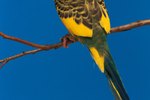One of the first and most consequential challenges in rescuing an orphaned baby bird is determining whether the bird is truly orphaned. In many cases, the mother bird is watching nearby, and the little guy doesn’t need your help. In fact, your interference may be the last thing the little bird needs. But there are a few thing you can do to help, either way.
When to Interfere
Unless a mother bird is sick or injured or has permanently abandoned the nest, she is likely waiting to return to her baby as soon as you leave the area. Watch for an hour or so from an obscure vantage point to see if the mother bird -- or the male parent, as the case may be -- returns to the baby. If a parent doesn’t return, or if one does but the baby does not seem able to respond, such as because of injury, it may be time to step in.
Is the Bird Injured?
First determine whether the bird is injured. Is there visible blood or trauma? Is the bird laying on his side or breathing heavily? Does he have sunken eyes? If the bird appears unhealthy or injured, take the bird to a veterinarian or wild bird rescue facility. Gently pick up the bird by supporting his body and legs in your cupped hands so he doesn’t flap his wings. Place him into a container such as a shoebox lined with a towel or tissue paper for transport.
Is It a Nestling or Fledgling?
If the bird doesn’t appear injured, the next step is to determine how old the baby is. If you can, try to get the bird to grasp your finger and use it as a perch. If he does, he is a fledgling and he may be learning to fly -- not orphaned.
Shelter the bird close to where you found it if the area is reasonably safe from predators. As much as possible, watch from a distance to keep predators away. The bird will be quite mobile when learning to fly — first hopping while flapping his wings, then gliding for longer and longer distances. He should be flying well enough to escape danger in less than a day.
If the bird is a nestling, look around for his nest and gently place him back in. If you can’t find the nest, line a small basket or similar container with tissue paper and place it in a nearby tree. Keep watch. If the mother doesn’t return within an hour, you will need to provide temporary assistance, as baby birds can’t live very long without eating.
Feeding a Baby Bird
The best chance a baby bird has is with people who have experience caring for baby birds. However, if you can’t immediately get the bird to a bird facility, you may need to feed the bird temporarily. The bird will need food every 20 minutes.
Some birds, such as chickens, turkeys and ducks, can peck from birth. Crush or grind up small seeds and mix the meal with a small amount of baby food. Place a small amount on the bird's beak, and put more on the floor of the enclosure.
Some birds -- such as doves, parrots and sparrows -- need hand-feeding. Mash up canned dog food or soften kibble. Feed with tweezers, being careful not to injure the throat. Provide a small saucer of sugar water. Do not force water down the bird's throat; it may aspirate into their lungs. Feed until the baby no longer opens his beak to be fed.
References
Photo Credits
-
Design Pics/Design Pics/Getty Images



